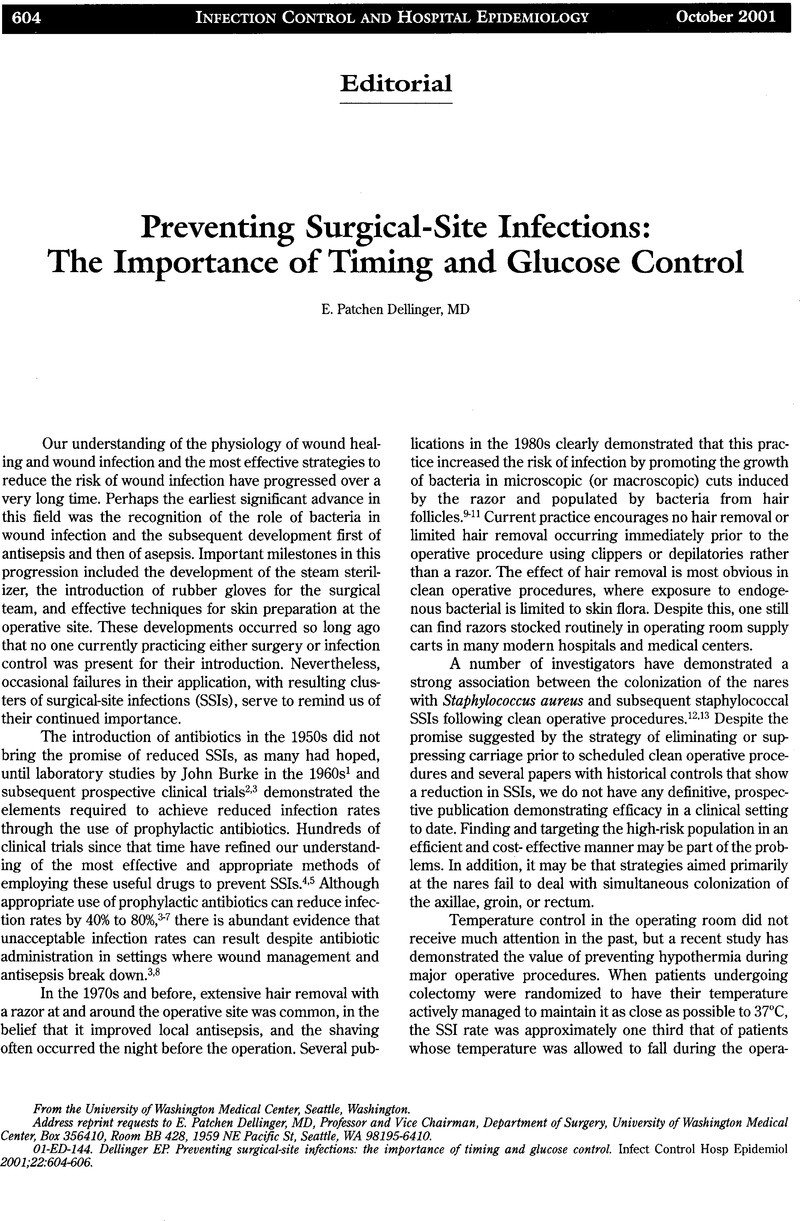Crossref Citations
This article has been cited by the following publications. This list is generated based on data provided by Crossref.
Kluytmans, Jan
and
Voss, Andreas
2002.
Prevention of postsurgical infections: some like it hot.
Current Opinion in Infectious Diseases,
Vol. 15,
Issue. 4,
p.
427.
Wilson, Stephen J.
and
Sexton, Daniel J.
2003.
Elevated Preoperative Fasting Serum Glucose Levels Increase the Risk of Postoperative Mediastinitis in Patients Undergoing Open Heart Surgery.
Infection Control & Hospital Epidemiology,
Vol. 24,
Issue. 10,
p.
776.
Dellinger, E. Patchen
Hausmann, Susan M.
Bratzler, Dale W.
Johnson, Rosa M.
Daniel, Donna M.
Bunt, Kathryn M.
Baumgardner, Greg A.
and
Sugarman, Jonathan R.
2005.
Hospitals collaborate to decrease surgical site infections.
The American Journal of Surgery,
Vol. 190,
Issue. 1,
p.
9.
Colgan, Stephen J.
Mc Mullan, Celene
Davies, Geoffrey E.
and
Sizeland, Andrew M.
2005.
Audit of the use of antimicrobial prophylaxis in nasal surgery at a specialist Australian hospital.
ANZ Journal of Surgery,
Vol. 75,
Issue. 12,
p.
1090.
Shann, Kenneth G.
Likosky, Donald S.
Murkin, John M.
Baker, Robert A.
Baribeau, Yvon R.
DeFoe, Gordon R.
Dickinson, Timothy A.
Gardner, Timothy J.
Grocott, Hilary P.
O’Connor, Gerald T.
Rosinski, David J.
Sellke, Frank W.
and
Willcox, Timothy W.
2006.
An evidence-based review of the practice of cardiopulmonary bypass in adults: A focus on neurologic injury, glycemic control, hemodilution, and the inflammatory response.
The Journal of Thoracic and Cardiovascular Surgery,
Vol. 132,
Issue. 2,
p.
283.
Spalter, Andrea W.
and
Wyatt, David A.
2006.
Antibiotic Prophylaxis and Surgical Site Infection: Are We Doing Enough to Ensure Quality?.
Perioperative Nursing Clinics,
Vol. 1,
Issue. 3,
p.
211.
Sessler, Daniel I.
2006.
Non-pharmacologic Prevention of Surgical Wound Infection.
Anesthesiology Clinics of North America,
Vol. 24,
Issue. 2,
p.
279.
Miyahara, Ken
Matsuura, Akio
Yoshida, Katsuhiko
Mizutani, Shinichi
Eda, Tadahito
Kawamura, Akemi
and
Kasamatsu, Masayuki
2007.
Preventing surgical site infection in cardiovascular surgery:.
Journal of the Japanese Society of Intensive Care Medicine,
Vol. 14,
Issue. 2,
p.
187.
Griffin, Frances A.
2007.
Reducing Surgical Complications.
The Joint Commission Journal on Quality and Patient Safety,
Vol. 33,
Issue. 11,
p.
660.
Lacara, Teresita
Domagtoy, Caroline
Lickliter, Donna
Quattrocchi, Kathy
Snipes, Lydia
Kuszaj, Joánne
and
Prasnikar, MaryClare
2007.
Comparison of Point-of-Care and Laboratory Glucose Analysis in Critically Ill Patients.
American Journal of Critical Care,
Vol. 16,
Issue. 4,
p.
336.
Elinav, Hila
Wolf, Zemira
Szalat, Auryan
Bdolah-Abram, Tali
Glaser, Benjamin
Raz, Itamar
and
Leibowitz, Gil
2007.
In-hospital treatment of hyperglycemia: effects of intensified subcutaneous insulin treatment.
Current Medical Research and Opinion,
Vol. 23,
Issue. 4,
p.
757.
Fletcher, Nicholas
Sofianos, DʼMitri
Berkes, Marschall Brantling
and
Obremskey, William T.
2007.
Prevention of Perioperative Infection.
The Journal of Bone and Joint Surgery-American Volume,
Vol. 89,
Issue. 7,
p.
1605.
Boston, Kelley M.
Baraniuk, Sarah
O'Heron, Shana
and
Murray, Kristy O.
2009.
Risk Factors for Spinal Surgical Site Infection, Houston, Texas.
Infection Control & Hospital Epidemiology,
Vol. 30,
Issue. 9,
p.
884.
Galway, Ursula A.
Parker, Brian M.
and
Borkowski, Raymond G.
2009.
Prevention of Postoperative Surgical Site Infections.
International Anesthesiology Clinics,
Vol. 47,
Issue. 4,
p.
37.
Liau, Kui-Hin
Aung, Khin-Thanda
Chua, Nelson
Ho, Choon-Kiat
Chan, Chung-Yip
Kow, Alfred
Earnest, Arul
and
Chia, Sing-Joo
2010.
Outcome of a Strategy To Reduce Surgical Site Infection in a Tertiary-Care Hospital.
Surgical Infections,
Vol. 11,
Issue. 2,
p.
151.
Bull, A.
Wilson, J.
Worth, L.J.
Stuart, R.L.
Gillespie, E.
Waxman, B.
Shearer, W.
and
Richards, M.
2011.
A bundle of care to reduce colorectal surgical infections: an Australian experience.
Journal of Hospital Infection,
Vol. 78,
Issue. 4,
p.
297.
Spratt, Deborah
Dutton, Richard P.
Dellinger, E. Patchen
Bird, Bruce
Guglielmi, Charlotte L.
Farber, Michelle
and
Groah, Linda
2012.
The Role of the Health Care Professions in Preventing Surgical Site Infection.
AORN Journal,
Vol. 95,
Issue. 4,
p.
430.
Weiser, Thomas G.
Porter, Michael P.
and
Maier, Ronald V.
2013.
Safety in the operating theatre—a transition to systems-based care.
Nature Reviews Urology,
Vol. 10,
Issue. 3,
p.
161.
Bratzler, Dale W.
Dellinger, E. Patchen
Olsen, Keith M.
Perl, Trish M.
Auwaerter, Paul G.
Bolon, Maureen K.
Fish, Douglas N.
Napolitano, Lena M.
Sawyer, Robert G.
Slain, Douglas
Steinberg, James P.
and
Weinstein, Robert A.
2013.
Clinical practice guidelines for antimicrobial prophylaxis in surgery.
American Journal of Health-System Pharmacy,
Vol. 70,
Issue. 3,
p.
195.
Hamlin, Nason P.
2013.
The Perioperative Medicine Consult Handbook.
p.
143.



